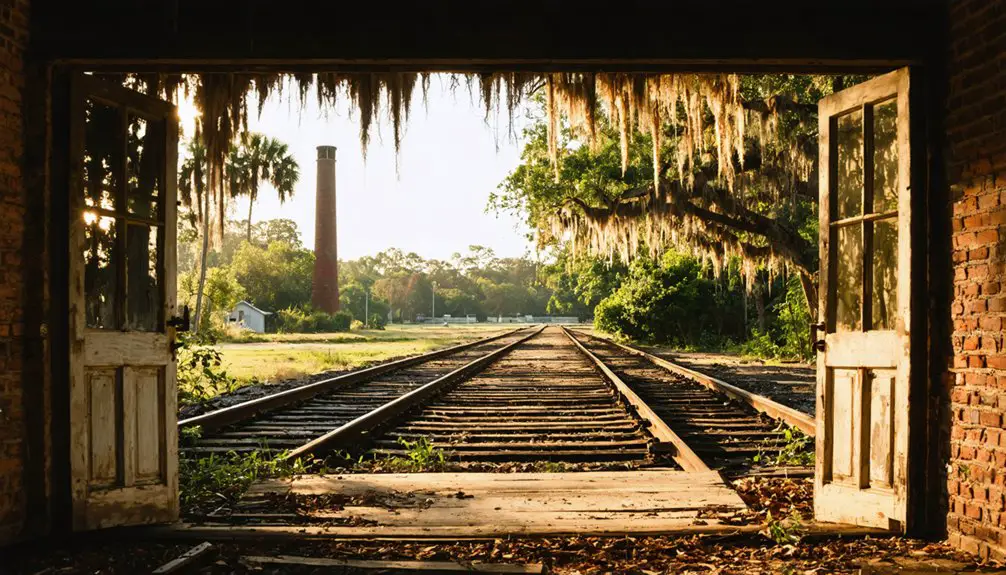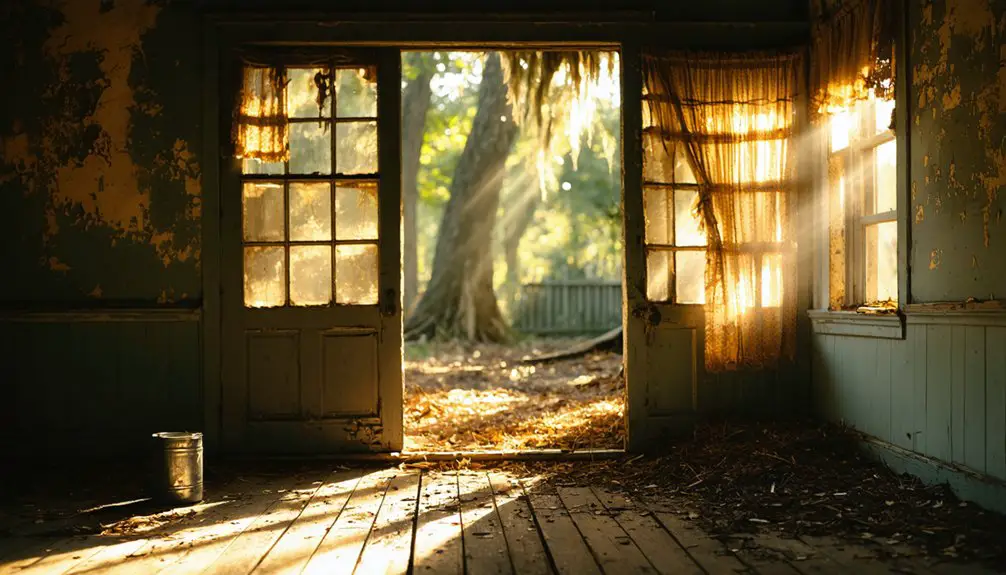You’ll find Buchanan’s ghost town ruins between Wekiwa Springs and the St. Johns River, where Chief Charlie Apopka’s influence first drew settlers in the 1840s. The town thrived as a turpentine community with the arrival of the Seaboard Air Line Railroad in 1900, reaching 250 residents at its peak. While harsh labor conditions marked its turpentine camps, the town’s decline came as pine forests depleted. Today, scattered houses and a lone antenna tower hold centuries of untold stories.
Key Takeaways
- Buchanan was a Florida settlement that thrived on turpentine production and railroad commerce before its eventual decline.
- African American workers endured harsh conditions in Buchanan’s turpentine camps, facing forced labor and exploitation.
- The Seaboard Air Line Railroad’s arrival in 1900 connected Buchanan to major Florida cities, reaching a peak population of 250.
- Environmental degradation and depletion of pine forests contributed to the town’s economic downfall and abandonment.
- Only scattered houses and an antenna tower remain today, with no historical markers commemorating the former community.
Origins of Charlie Apopka Settlement
While Florida’s statehood in 1845 catalyzed settlement in the Apopka region, the area’s rich natural environment had long attracted both Native Americans and early pioneers.
You’ll find the settlement’s roots deeply intertwined with Seminole heritage, particularly through Chief Charlie Apopka, whose influence lives on in local place names. The early settlers established places of worship including The Lodge, which served multiple Christian denominations.
The area’s settlement patterns evolved as Seminole War soldiers received bounty land grants, while others purchased acres at $1.25 under the 1820 Congressional Act. Settlers began actively clearing the land for growing cotton, corn, and sugar cane.
The landscape’s abundant water sources, including Wekiwa Springs and the St. Johns River, drew settlers to establish communities.
Following the Seminole Wars and subsequent displacement of native peoples, American settlers gained control of these fertile lands, transforming them into agricultural ventures and transportation hubs.
Life in a Turpentine Town
Once thriving across North Central Florida’s pine forests, turpentine camps emerged as harsh company towns where workers, mainly African American men, labored under brutal conditions to extract valuable pine sap.
Hidden in Florida’s dense pinelands, turpentine camps imprisoned Black workers in a ruthless system of forced labor and exploitation.
The turpentine culture revolved around systematic labor exploitation, with workers forcibly recruited through local law enforcement and trapped in a cycle of debt at company stores. Payment in company scrip only meant workers were completely dependent on inflated company store prices. The industry relied heavily on convict labor until 1923, with inmates working without pay.
You’d find workers scaling pine trees weekly, creating “cat faces” or using Herty cups to collect resin, earning merely 50 cents to $1 per day.
- Armed guards patrolled the camps’ perimeters, preventing workers from leaving
- Your wages would be stripped away at the company store’s inflated prices
- You’d face physical punishment for any perceived defiance or slow work
- The isolation of these camps meant you’d have nowhere to turn for help
The Seaboard Airline Railroad Era
The arrival of the Seaboard Air Line Railroad (SAL) in 1900 marked a new chapter in Buchanan’s story, shifting the town’s focus from turpentine production to rail commerce.
You’d have witnessed SAL’s ambitious Seaboard expansion through Florida, as the railroad stretched its network from Richmond down to Miami, transforming small towns like Buchanan into crucial links in a growing transportation chain.
SAL’s Railroad legacy brought unprecedented connectivity to Buchanan, connecting you to major Florida cities and northern markets. The railroad became known as The Route of Courteous throughout its service area.
The railroad’s presence meant you could ship local products more efficiently, while passenger services brought fresh faces through town. The railway handled an impressive 33 million tons of freight during World War II, showcasing its vital role in transportation.
Economic Rise and Decline
You’ll find that Buchanan’s early economic rise centered on the turpentine industry, which thrived alongside the Seaboard Airline Railroad‘s essential transportation links through Florida’s pine forests.
The railroad’s presence sparked increased trade activity and allowed turpentine producers to efficiently ship their products to larger markets throughout the Southeast. Local businesses included hotels and saloons that served the growing population. Similar to how many towns in the Great Plains states suffered abandonment, Buchanan faced economic challenges that would seal its fate.
As the surrounding pine forests became depleted from intensive turpentine harvesting practices, Buchanan’s economic foundation began to crumble, leading to its eventual decline.
Turpentine Industry Dominance
During Buchanan’s peak years from the late 1800s to 1920s, turpentine production dominated the local economy, capitalizing on vast longleaf pine forests that covered North Florida.
You’d find the Knabb family’s empire stretching across 200,000 acres, where workers extracted valuable pine sap using “cat-face” cuts. Each 50-gallon batch yielded 325 pounds of pitch and 10 gallons of turpentine, fueling the naval stores industry’s demand for wooden ship preservation. Workers often received payment in company script, leaving them perpetually indebted to the company store. The dangerous work mirrored conditions across Florida’s turpentine camps, where debt bondage systems trapped laborers.
- Workers endured brutal conditions in isolated camps, earning mere cents while trapped in debt.
- Guards patrolled roads to prevent escape from the forced labor system.
- The Knabb operations gained national infamy for their peonage practices.
- Despite federal investigations in 1936, labor exploitation continued until the industry’s decline.
Railroad Trade Impact
When Florida Railroad completed its east-west line in 1861, Buchanan’s fortunes dramatically shifted as the new rail connection slashed maritime shipping distances by 800 miles between Gulf and Atlantic ports.
You’d have seen the town transform into a bustling trade hub as railroad infrastructure connected local merchants to major markets year-round, regardless of river conditions or weather.
The town’s prosperity peaked as timber and agricultural goods flowed freely along the new trade routes, while warehouses and service industries sprouted up around the rail terminals.
But you wouldn’t recognize Buchanan’s vibrancy for long – as railroad companies began prioritizing other routes and newer shipping technologies emerged, the town’s economic lifeblood slowly drained away.
The reduced rail service eventually forced businesses to relocate, leading to Buchanan’s commercial collapse.
Resource Depletion Effects
While saltworks operations and cotton farming initially fueled Buchanan’s growth in the late 1800s, the town’s economic fate hinged on factors beyond simple resource depletion.
You’ll find that environmental impact, rather than resource scarcity, sealed the town’s destiny when the 1937 construction of Buchanan Dam submerged the entire settlement underwater. The flood waters transformed a thriving community into an underwater ghost town.
- Your ancestors’ homes, businesses, and the historic cotton gin now rest beneath Lake Buchanan’s waters.
- During severe droughts (1984, 2009, 2011), you can glimpse the town’s preserved foundations emerging from the depths.
- You’re witnessing the stark reality of how dam construction forever altered local commerce and community life.
- Your connection to the past remains intact through protected underwater artifacts and structures.
Daily Life and Community Structure
As residents of early 20th-century Buchanan settled into their daily routines, life centered primarily around the town’s turpentine operations and railroad activities.
You’d find families like the Whiddens, Boyettes, and McClellans working closely together in the pine forests, extracting valuable turpentine in the sweltering Florida heat.
The town’s social fabric was tightly woven, with just 250 residents at its peak in 1900.
Small but close-knit, Buchanan’s 250 residents formed an intimate community where everyone knew their neighbors and shared daily life.
Community activities revolved around shared labor, while social gatherings likely occurred at common meeting spots near the railroad station or post office.
You’d experience a typical rural Florida lifestyle, where families supported each other through mutual aid and daily interactions.
The post office served as an essential hub for news and communication until its closure in 1925.
Legacy and Remaining Traces

If you visit Buchanan’s ghost town site today, you’ll find the large antenna tower standing as the most prominent remaining structure amid 9-10 scattered houses that have lost much of their historical character.
You’ll notice an almost complete absence of physical evidence from the town’s turpentine industry heyday, with most structures having vanished over time.
The site’s location near the Ben Hill Griffin/Sweetwater Road intersection remains one of the few fixed reference points, though no historical markers or monuments commemorate the former community’s existence.
Historical Site Preservation
Despite its physical decline, Buchanan’s legacy endures through a combination of local preservation efforts and cultural memory.
You’ll find preservation challenges being met through grassroots initiatives, with historical societies and volunteer groups working to protect remaining artifacts and landmarks.
Community involvement plays an essential role, as local educators and residents collaborate to incorporate Buchanan’s story into regional curricula and heritage events.
- Walk among the cat-faced pines that still bear the scars of the turpentine industry, silent witnesses to a bygone era
- Discover the carefully cataloged artifacts that tell the story of early 20th-century industrial practices
- Experience the power of oral histories passed down through generations of local families
- Connect with volunteer groups who protect these historical traces for future generations
Documented Physical Evidence
While Buchanan’s physical remnants tell multiple stories across Florida, the most dramatic evidence lies beneath Lake Buchanan’s waters, where the submerged ruins of Old Bluffton emerge during severe droughts.
Since the 1980s, you’ll find foundations of homes, businesses, and a cotton gin revealed when water levels drop, with archaeological findings documented by the Texas Historical Commission.
The town’s artifacts remain exceptionally preserved underwater, protected by law from removal. You can spot remnants of a local bank, hotel, and even tombstones during low water events.
Fort Dade on Egmont Key offers additional traces, with its brick roads and military batteries still visible, while Centralia’s logging heritage survives through scattered foundations and railroad remnants in the Chassahowitzka Wildlife Management Area.
Frequently Asked Questions
Are There Any Ghost Stories or Legends Associated With Buchanan?
You won’t find any documented spectral sightings or Buchanan hauntings in historical records. Unlike some ghost towns with spooky legends, this former turpentine town’s decline stems purely from economic factors.
Can Visitors Legally Explore the Remains of the Ghost Town Today?
You shouldn’t explore without permission since it’s likely private property. There aren’t any official exploration regulations or visitor safety protocols in place – you’ll need landowner approval to legally visit.
What Happened to the Residents When They Abandoned the Town?
Like birds seeking warmer winds, residents scattered to nearby towns following economic decline. You’ll find their migration patterns led to surrounding areas where they rebuilt lives, carrying community memories with them.
Were There Any Major Disasters or Events That Contributed to Decline?
You’ll find no sudden catastrophic events triggered Buchanan’s demise. Instead, economic decline from the turpentine industry’s downturn and the railroad’s closure in 1984, plus harsh environmental factors, gradually emptied the town.
Are There Any Surviving Photographs of Buchanan During Its Peak?
A picture’s worth a thousand words, but you won’t find any here. Despite searching historical archives and vintage postcards, there’s no evidence of surviving photographs from Buchanan’s peak period.
References
- https://www.youtube.com/watch?v=x1VRUi_TwoY
- https://floridatrailblazer.com/category/ghost-towns/page/2/
- https://www.ghosttowns.com/states/fl/buchanan.html
- https://www.tiktok.com/@forrestfromtexas/video/7232439532749278510?lang=en
- https://en.wikipedia.org/wiki/List_of_ghost_towns_in_Florida
- http://www.geocities.ws/krdvry/hikeplans/apopka/planapopka.html
- https://stars.library.ucf.edu/cgi/viewcontent.cgi?article=1155&context=cfm-texts
- https://theapopkamuseum.com/history-of-apopka/
- https://en.wikipedia.org/wiki/Seminole_Wars
- https://en.wikipedia.org/wiki/Charlie_Creek_(Florida)



